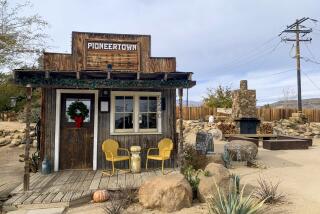The Hunter S. Thompson of real estate
- Share via
Sometimes the truth hurts. Real estate salesman Jim Klinge doesn’t care.
Cruising through the sunny hills of Carlsbad in a massive silver Mercedes-Benz, he looks like any other pitchman of the California dream.
But Klinge, 50, has become a notorious Internet chronicler of the real estate crash in north San Diego County, where he has lived and worked for decades.
Rather than downplay the greed and excess that caused the region’s travails, he revels in exposing them.
He surveys the wreckage with a pocket video camera, shooting footage of vacant, once-pricey houses turned into eyesores, voiced over with his deadpan narration. Then he posts them on his website, at www.bubbleinfo.com.
They’re shaky, noisy clips full of coarse images and language.
“Would you spend a million dollars for that house?” he says in one video, showing a two-story, boxy wreck with the rushing sound of a freeway in the background.
Why does he do it? To sell houses.
Klinge is a real estate broker, has been since 1984. He just doesn’t act like one.
In the summer of 2005, Klinge says, he sensed the housing crash coming. He had been through the real estate downturn in the early 1990s and was wary that the red-hot market couldn’t last.
But his real estate industry colleagues continued to declare that home values would keep soaring.
Most agreed with David Lereah, then the chief economist for the National Assn. of Realtors, who finessed the question of the market bubble this way: “I could think of froth as effervescence rather than some popping of bubbles,” he told the San Francisco Chronicle in June 2005.
Klinge heard the same thing from fellow brokers in San Diego. He felt that such talk emboldened buyers to take on more debt than they could afford and prompted sellers to ask too much for their houses, which would cost them time and money as their homes went unsold. He started blogging, his first post questioning the 20% to 30% annual home price appreciation in some neighborhoods, and arguing that “sellers have gotten too optimistic and are pricing their houses WAY too high.”
Nowadays, Klinge said, his blog gets about 2,000 unique visitors per day. About half his clients now come to him from the blog, Klinge said. He closed 43 house deals last year, he said, down from the 61 sales and purchases he brokered in his peak year of 2004, but enough to keep him in business when many agents have quit.
Lately, his videos have been picked up on Calculated Risk, an influential economics blog whose followers include Nobel laureate Paul Krugman. In one clip, the camera pans across the kitchen of a million-dollar fixer near Interstate 5. He pointedly notes the house’s proximity to the freeway, which he calls the “De-troit river.” There’s mold under the sink and a foot-sized hole in the drywall just above the floor.
“December 2006 this house sold for a million dollars,” he says. “Nineteen hundred square feet, built in ‘78, right across the freeway. One million.”
On the off-chance the real estate agent who sold the place is watching, Klinge puts in a request: “I want you to put your mai tai down, go grab your shingle and send it in to the DRE [California Department of Real Estate] right now. You don’t deserve a job,” he says. “Everyone who was on that deal deserves to be fired, even the janitor at the escrow company. This is embarrassing, $1 million. Right now it’s listed at $575,000 and that’s probably optimistic.”
Along with the house wreck videos, the site includes statistics on local home sales totals and price declines. Klinge has skewered brokers on the blog, calling them names like “clown” and “cherry-picking cheerleader” for not admitting that the housing market had tumbled. But he said no one had gotten upset enough to retaliate.
Klinge didn’t start out as the Hunter S. Thompson of real estate. He used to believe. In 1987, just three years into his career, Klinge had set up his own office in La Jolla and was riding the rising real estate market. He was convinced home prices would keep soaring.
“Everybody wants to live in La Jolla,” he said, repeating what he and everyone else were saying then.
Klinge learned the hard way that even chic beach communities go down when the housing market tanks. “By the end of 1990 I could not find a buyer. I had no idea what to do, I had no history or experience” with a down market, Klinge said, “like a lot of agents today.”
He closed his office and became a mortgage broker. Arranging refinances got him through the 1990s real estate slump, and he returned to home-selling in 1995.
Klinge said the 1990 real estate downturn made him cautious as home prices skyrocketed in this decade. “I never got overly bubbleicious,” he said. His blog’s underlying theme, he said, has been “You can’t forget this is a regular business cycle. There are ups and downs, and you’ve got to plan for that.”
He knew the market was headed for a crash, he said, one day in July 2005, when he had just come home from a family trip to Disney World and answered the phone. The woman on the line had seen a house that Klinge was selling.
“Up until that point, the only thing buyers wanted to know was how much over list they needed to offer. All of a sudden this lady was being critical of everything, the property, the price. I hung up the phone and told my wife, ‘It’s over,’ ” he said.
A few weeks later, he started blogging. His wife, Donna, who helps manage the family brokerage, was nervous. “He was really pushing the envelope with the blog, taking people on, naming names,” she said. “I took deep breaths. I didn’t know how it would turn out.”
She said she was shocked one day to see a photo on the blog of two young men sitting on the floor of a house with their wrists bound like prisoners. They had been squatting in a foreclosed house Jim was selling, and he had sneaked up on them as they slept and tied them up with plastic zip ties in a brazen citizen’s arrest.
But Donna, who began dating Jim when they were at Cal State Fullerton in the early 1980s, had after 20 years of marriage grown accustomed to his provocative style. So far, he’s known when to stop pushing, both on the blog and with her and their two daughters, she said.
He also manages to keep things civil with his industry colleagues, a notoriously upbeat lot. Kris Berg, another San Diego County real estate broker who writes a blog as sweet as Klinge’s is sour, says Klinge “is a nice guy, a great guy.”
Does he offend other real estate brokers? Berg said she’s not heard anything directly, but is sure he must, simply because “there’s an inherent danger when you take transparency to that level. You’re going to alienate people,” she said.
Klinge figures that if he alienates some real estate agents but attracts more customers, it’s all worth it.
Marc Needham, 33, was a fan of Klinge’s blog for a year before becoming a client. He and his wife had looked for a house for a few months in 2007 with another agent but became fed up. “We had banks lying to us; our previous real estate agent lied to us,” he said.
Needham said the agent and lenders told him the housing market would soon rebound and pushed him to pursue houses he felt he couldn’t afford, places he said would have required spending 40% to 45% of his income on house payments.
Needham, a Web marketing director for a hospital chain, said he appreciated that Klinge agreed with his view that the housing market was more likely to keep falling than to quickly bounce back.
Represented by Klinge, the Needhams bought a four-bedroom house in Encinitas last year for $580,000. Needham said his house is probably worth less now, but he expected the decline, and Klinge also helped him avoid properties with problems he did not see.
Klinge recently took a reporter along when he visited a house with Christine Liashek, 29, a first-time home buyer. He did more warning than selling. She was drawn to a cozy, 1960s three-bedroom Carlsbad house with a swimming pool. It was just the size she and her husband -- they have a dog but no children -- were looking for. Standing in the living room, Liashek looked to Klinge for his opinion.
“That was the high school out there,” Klinge said, nodding his head toward the front door, “You’re going to have night football games, people parking here,” Klinge told her. “The baseball field’s out there too. You’ll probably hear the batting practice.”
Liashek still liked the house enough to ask him to show it to her husband later, which Klinge agreed to do. Then she asked him about a new home development nearby.
“I call it Foreclosure Ranch,” Klinge said. “The reputation concerns me. It’s probably the worst place in Carlsbad for foreclosures, and it’ll be hard to shake that,” he warned.
Liashek and her husband passed on the new development and the house near the high school.
But they’re still looking with Klinge. Unlike previous generations of home buyers, who relied on their real estate agents to provide them with lists of homes to view, Liashek finds properties herself on websites such as SDlookup.com, Redfin and ZIP Realty and e-mails Klinge the addresses of houses she’s interested in. Klinge will let her know which ones aren’t worth a visit.
“He’ll say this one’s under power lines, that one’s by the freeway, that one’s in a bad school district,” Liashek said.
“You do not have to waste your time going around in circles with Jim,” she said. “I really appreciate that honesty.”
But don’t expect other agents to start bad-mouthing one another’s houses and tying up teenagers.
Or even, Klinge says, highlighting the risks in a shaky market.
“They’re chicken,” Klinge said.
--
More to Read
Inside the business of entertainment
The Wide Shot brings you news, analysis and insights on everything from streaming wars to production — and what it all means for the future.
You may occasionally receive promotional content from the Los Angeles Times.







